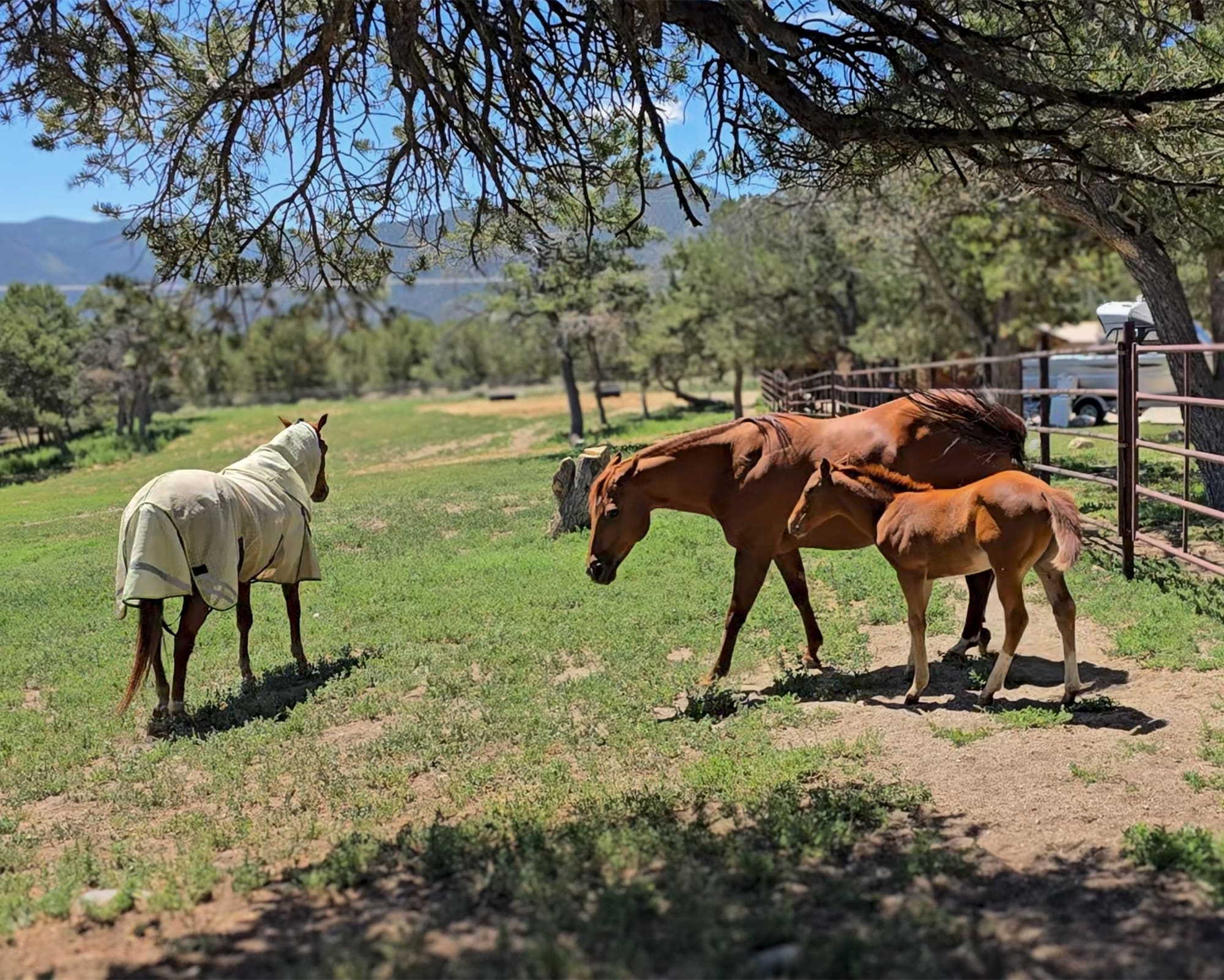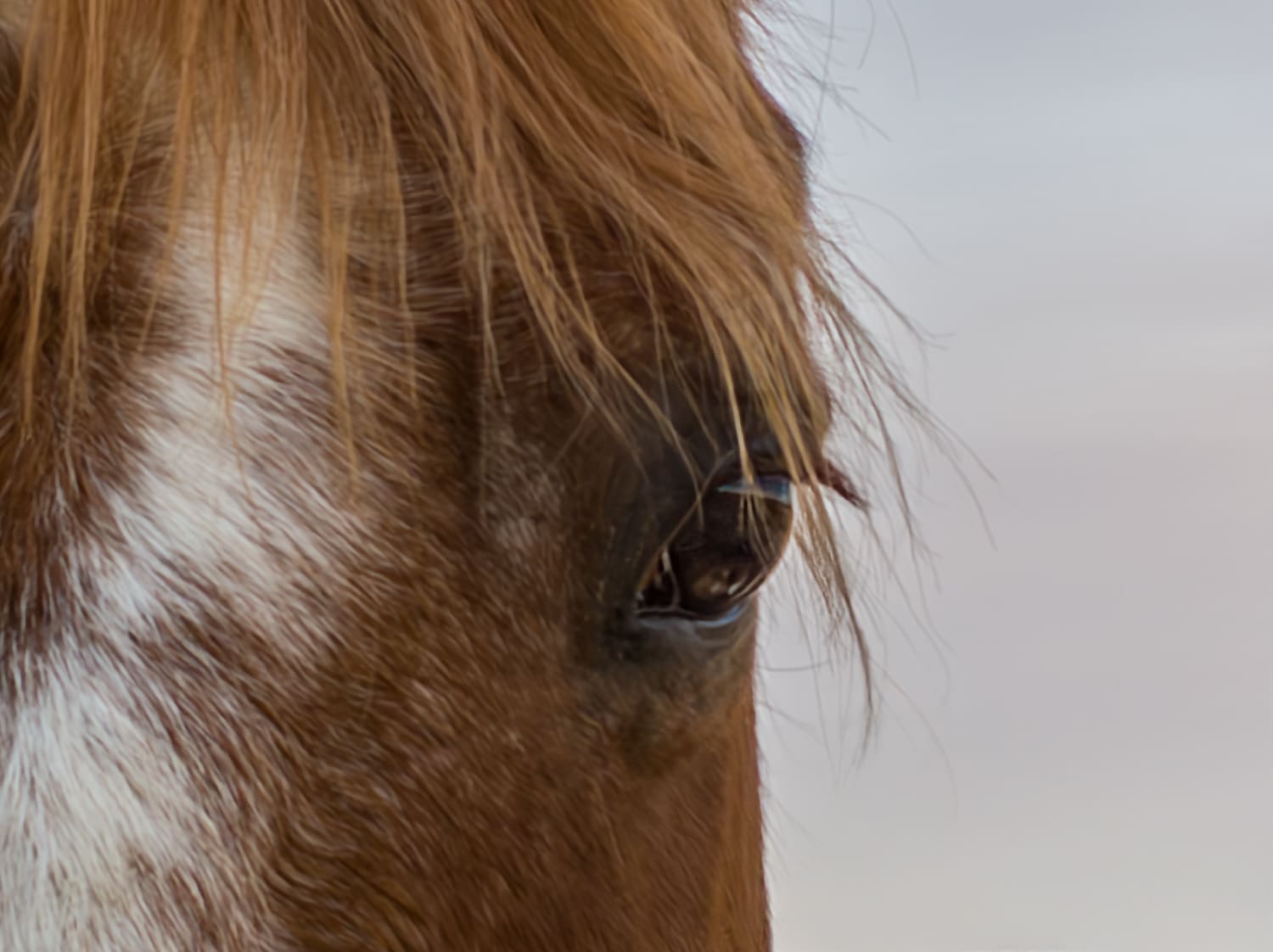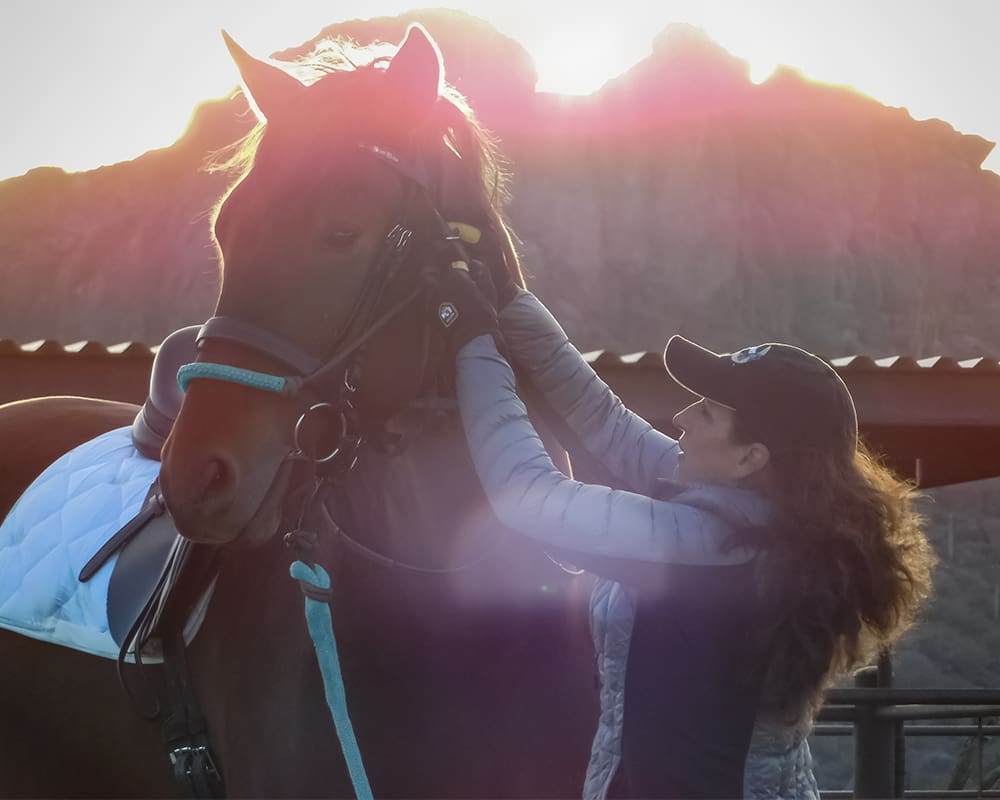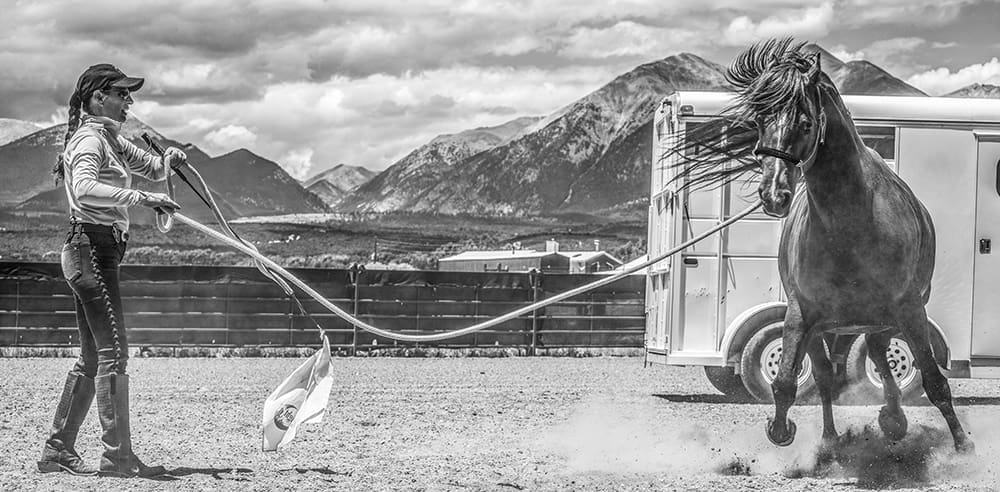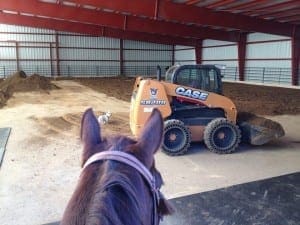 It’s time to dish some dirt—about dirt. I figured out that I stand, walk or ride in more than 50 arenas each year. Over several decades of riding horses and teaching clinics that means I’ve visited thousands of arenas. I’ve worked in indoors and outdoors, some home-made and some highly engineered, some heated and air-conditioned, some with most any footing you can imagine– sand, clay, stone dust, fiber, rubber from tires, rubber from tennis shoes, leather, wool, waxed sand. I’ve worked in arenas in all 50 states plus several other countries. I’m not sure what constitutes expertise in arena footing, but I know what I like and especially what I don’t like.
It’s time to dish some dirt—about dirt. I figured out that I stand, walk or ride in more than 50 arenas each year. Over several decades of riding horses and teaching clinics that means I’ve visited thousands of arenas. I’ve worked in indoors and outdoors, some home-made and some highly engineered, some heated and air-conditioned, some with most any footing you can imagine– sand, clay, stone dust, fiber, rubber from tires, rubber from tennis shoes, leather, wool, waxed sand. I’ve worked in arenas in all 50 states plus several other countries. I’m not sure what constitutes expertise in arena footing, but I know what I like and especially what I don’t like.
Some arenas are wonderful with little dust and just the right amount of cushion; some are sloped and maybe need some leveling or dust help. I’ve worked in arenas that can have a puddle in one end and be dusty and hard at the other end. In good arenas the footing is not only level but a consistent depth—consistency you and your horse can rely on; while others have deep pockets here and there and hard or slick spots elsewhere. Firmer or softer, it’s the consistency that counts.
This past year, I have thought much more about footing than usual. I decided last winter –after years of dissatisfaction with the footing in my indoor arena– that I would splurge on new footing. Living in the high mountains of Colorado, our winters aren’t exactly easy. We are relegated to riding indoors for about four to five months—more than a third of the year, and with all the time I spend in there, I want it to be perfect!
Have you thought about the ground your horses are working on lately? I sometimes worry that we pay so much attention to what goes on our horses legs and feet and backs, but little attention to what the horse is actually stepping on. If you ride out on the trail, you have to be ready for anything, but if you’re riding in an arena, it is important to think about what you’re asking your horse to perform on each day.
I want my horses on a surface that will allow the horse to work to the best of its ability with the least amount of stress and strain. And I want it to be level, consistent and dust-free. Plus, it must stand the test of time, holding up to the daily pounding of horse hooves and the regular grooming that makes it look and feel brand new.
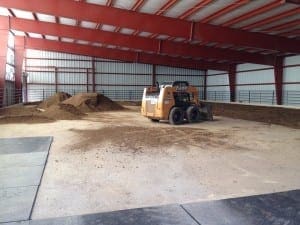
Form to Function:
Think of taking a jog or working out on different surfaces. Do you think you feel different after a workout running on concrete versus a clay athletic track? Now how do you feel after a barefoot run on the beach? Your horse adapts to each footing that he’s asked to run upon just like us humans, but some surfaces are better than others.
I used to live in southern Colorado, just north of the Great Sand Dunes National Park. I know many of you live in places where you would kill to have an unlimited supply of sand, but when your arena sits on top of a sand dune, it’s too much of a good thing. It was a great pen for riding colts, because they were working too hard to even think about bucking or running off!
Even the slightest slope in an arena will cause changes of balance in your horse as you ride. I’ve worked in lots of arenas (including my own outdoor) that have gradual slopes. Most people would not be able to see the slope, but it affects the horse’s balance. With a green horse, you’ll be checking his speed on the downhill slope a good time to work on slow trot is on the uphill track. Be sure to think about any gradual slopes the next time you feel your horse speed up or slow involuntarily. The footing has an impact!
Footing is critical to the horse’s ability to perform, the stress and strain on his limbs, his respiratory health and his willingness to work. And for me, nothing is more pleasing than awesome footing and a freshly groomed arena.
The Bad:
I know what I didn’t want—straight sand, rocks constantly working their way up, uneven depth or too much depth. I knew I didn’t want materials that were so fine it would be dusty or sticky or clumpy. I didn’t want dust or slippery when wet.
I’ve ridden horses for half a century and a lot of that time has been spent in dusty arenas. I knew I didn’t want a material that would lead to high dust. The rider is not nearly as prone to sucking in the dust as the horse is (or the trainer that is standing on the ground). Respiratory problems in trainers and riding instructors are clearly an occupational hazard—lots of us are sporting inhalers by the time we reach the pinnacle of our careers. And I know lots of older horses with the heaves too; dust can be a huge contributing factor to these conditions. Whether you water for dust control or use a dust reduction product like I do, the materials you choose will have a bearing on your ability to control the dust.
The Good:
Constructing good footing for an indoor arena can be quite different from an outdoor, but in my experience, the sub-base in any arena is the most important layer (and the easiest layer to mess up). That’s where the leveling, layering and machine compaction takes place. Also, the sub-base is the important layer for drainage. If you have drainage concerns, it pays to have an expert build your sub-base with drains, crowning and/or a slight slope so that your arena stays useful in all conditions and dries off quickly.
For me, the sub-base for my indoor arena footing had to be laser-level, with a geo-textile fabric barrier between the native subgrade (the rocks) and the finish footing. We needed a chemical binder added to substitute for the lack of clay available in this area, in order to provide more compaction. The end result was as smooth and level as a marble counter-top but had good traction and would hold up to the constant beating of hooves.
For my finish footing, I knew I wanted a combination of sand and clay in my indoor arena. As I mentioned, straight sand is too hard on the horse if he has to push it. A little bit of clay, machine blended into the sand, will give enough compaction to give the horse some rebound and slide, but too much clay will cause the footing to get too hard too fast. Finding the right mixture for the type of riding you do is no easy task, but we have sampled and tested different blends and come up with what I think is the perfect formula.
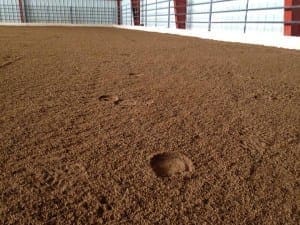
How it’s Made:
While working to get my own new footing, I’ve learned a lot about dirt and constructing perfect surfaces. I guess at first I thought that if you wanted a mix, you just got a load of sand and a load of clay. I wasn’t imagining how that would mix. It doesn’t really work to take your kitchen mixer out to the arena. You can’t just add a load of sand to a load of clay and mix it in place easily.
Instead, my new finish footing was machine blended to an exact ratio, at a pit about 150 miles away where clay was available. A huge system of vats and conveyor belts, controlled by a computer and blended and tested to meet a rigid standard. They hauled it to us in rear-dump semi trucks—five loads, 150 tons.
Then the dirt had to be hauled by dump truck into the arena and placed carefully, using a frame and a bobcat to screed the footing evenly without driving on it so that the depth and compaction was even throughout the entire building. The builders of my new arena footing were meticulous and conscientious, never cutting any corners and taking great pride in their work.
Getting Help:
Working with experts in arena construction, materials blending and surfaces for sports has taught me a great deal. You wouldn’t think there was much to arena dirt, until you talk to experts—it was a thrill to meet people that were more passionate about dirt than I was. The folks at G&S Sports Solutions taught me a lot (https://golfandsportsolutions.com/equine). I knew what I wanted for the end result, but I had no idea how to get there.
There are so many considerations in building good footing for your riding arena. The type of riding you do will have a bearing on the depth and firmness you want; the drainage you need, the cushioning and support, the dust and dust reduction methods you use, the natural materials available and the native soil conditions will all have a bearing on how your footing is built.
One thing I’ve learned, from building my own arenas and working in so many others, that this is no place to cut corners or take advice from anyone who is not an expert. I’ve had well-meaning advice from dirt-moving guys that know nothing about riding or horses and as a result, I’ve wasted a lot of money. Doing it right and getting expert help along the way always pays off in the end.
Already, G&S has made what I thought were big projects into easy work. They act fast and know their dirt. I highly recommend checking them out and learning more about the footing options (and how to clear space and prepare for your own riding arena.) If you’re farther from their “pit”, they can still help you find the right mix and the right way to get started in your area.
Stay tuned for more information about how to set up your own riding arena with the perfect footing. I’ll share more thoughts and suggestions as I get to ride on my own perfect footing.
###
